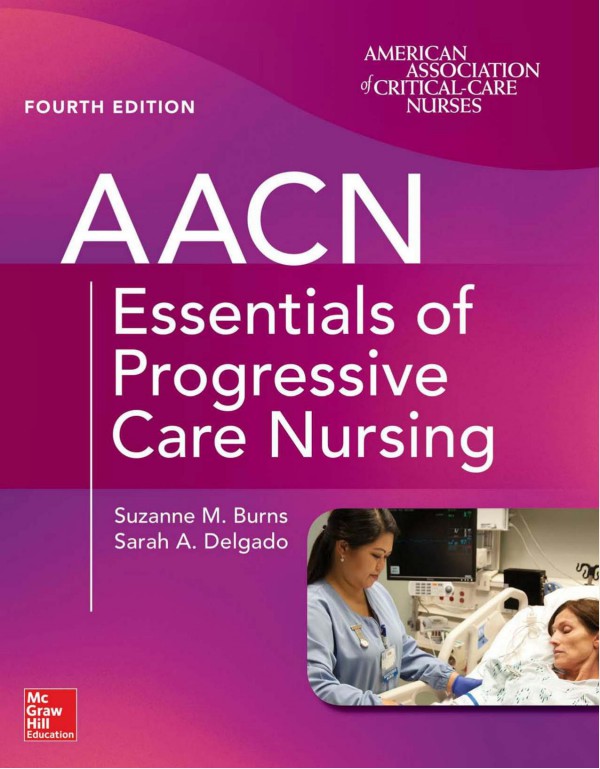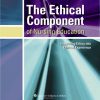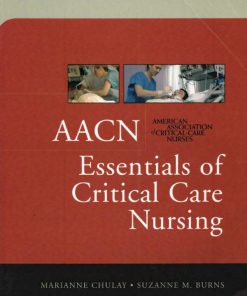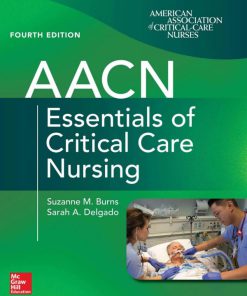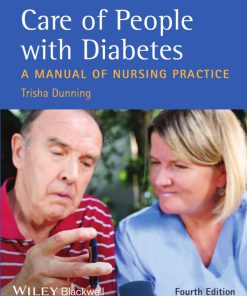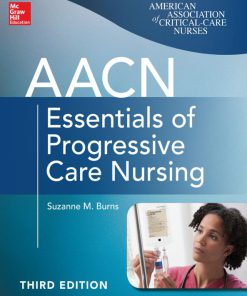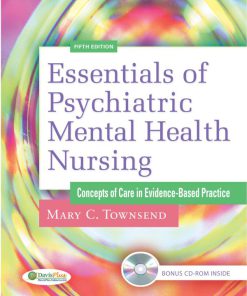AACN Essentials of Progressive Care Nursing 4th edition by Suzannne Burns, Sarah Delagado ISBN 1260116735 978-1260116731
$50.00 Original price was: $50.00.$25.00Current price is: $25.00.
Authors:Suzanne M. Burns , Series:Nursing [156] , Author sort:Burns, Suzanne M. , Languages:Languages:eng , Published:Published:Apr 2020 , Publisher:McGraw Hill
AACN Essentials of Progressive Care Nursing 4th edition by Suzannne Burns, Sarah Delagado – Ebook PDF Instant Download/Delivery. 1260116735 978-1260116731
Full download AACN Essentials of Progressive Care Nursing 4th edition after payment
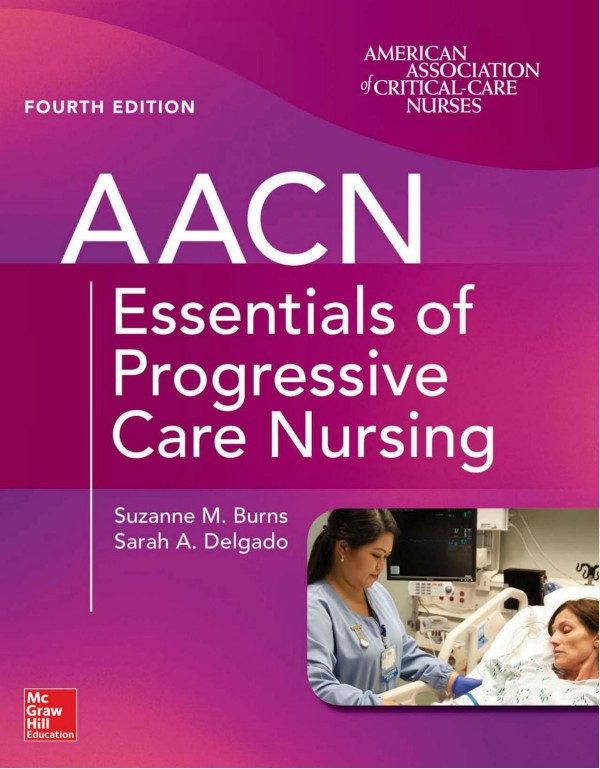
Product details:
ISBN 10: 1260116735
ISBN 13: 978-1260116731
Author: Suzannne Burns, Sarah Delagado
Succinct, complete guidance on how to safely and competently care for adult progressive care patients and their families – written by top clinical experts
Endorsed by the American Association of Critical-Care Nurses (AACN), this acclaimed textbook sets the standard for progressive care nursing education. Recognizing the learner’s need to assimilate foundational knowledge before attempting to master more complex progressive care nursing concepts, the book features a practical building-block organization that starts with the basics and logically moves on to advanced topics.
Bolstered by helpful tables and Essential Content cases, AACN Essentials of Progressive Care Nursing, Fourth Edition is an essential tool for clinicians at the point of care, and those preparing for PCCN® certification in progressive care nursing.
AACN Essentials of Progressive Care Nursing is divided into four sections:
• The Essentials presents essential information that clinicians must understand to provide safe, competent nursing care to progressive care patients, regardless of their underlying medical diagnoses.
• Pathologic Conditions covers pathologic conditions and management strategies commonly encountered among adult, progressive care patients.
• Advanced Concepts in Caring for the Progressive Care Patient presents advanced progressive care concepts or pathologic conditions that are less common or require more specialized management.
• Key Reference Information features normal laboratory and diagnostic values; pharmacology tables; and summary tables of cardiac rhythms, ECG characteristics, and treatment guides.
Learning aids include Knowledge Competencies to gauge progress, Principles of Management to summarize key concepts, and “Essential Content” case studies with questions and answers to further reinforce the learners’ knowledge.
AACN Essentials of Progressive Care Nursing 4th Table of contents:
Section I. The Essentials
1. Assessment of Progressive Care Patients and Their Families
Assessment Framework
Prearrival Assessment
Arrival Quick Check
Comprehensive Initial Assessment
Ongoing Assessment
Patient Safety Considerations in Admission Assessments
Prearrival Assessment: Before the Action Begins
Admission Quick Check Assessment
Airway and Breathing
Circulation and Cerebral Perfusion
Chief Complaint
Drugs and Diagnostic Tests
Equipment
Comprehensive Initial Assessment
Past Medical History
Social History
Physical Assessment by Body System
Transition/Discharge Planning
Ongoing Assessment
Principles of Management
Selected Bibliography
Progressive Care Assessment
Evidence-Based Practice
2. Planning Care for Progressive Care Patients and Their Families
Interprofessional Plan of Care
Planning Care Through Staffing Considerations
Patient Safety Considerations in Planning Care
Prevention of Common Complications
Physiologic Instability
Venous Thromboembolism
Hospital-Acquired Infections
Pressure Injury
Sleep Pattern Disturbance
Falls
Psychosocial Impact
Patient and Family Education
Assessment of Learning Readiness
Strategies to Address Patient and Family Education
Outcome Measurement
Family-Centered Care
Transporting the Progressive Care Patient
Assessment of Risk for Complications
Level of Care Required During Transport
Preparation
Transport
Interfacility Transfers
Transitioning to the Next Stage of Care
Supporting Patients and Their Families During the Dying Process
Principles of Management
Selected Bibliography
Patient and Family Needs
Infection Control
Patient and Family Education
Psychological Problems
Sleep Deprivation
Transport of Critically Ill Patients
Evidence-Based Practice
3. Interpretation and Management of Basic Cardiac Rhythms
Basic Electrophysiology
ECG Waveforms, Complexes, and Intervals
P Wave
QRS Complex
T Wave
U Wave
PR Interval
ST Segment
QT Interval
Basic Electrocardiography
Cardiac Monitoring
Determination of the Heart Rate
Determination of Cardiac Rhythm
Common Dysrhythmias
Rhythms Originating in the Sinus Node
Normal Sinus Rhythm
Sinus Bradycardia
Sinus Tachycardia
Sinus Dysrhythmia
Sinus Arrest
Dysrhythmias Originating in the Atria
Premature Atrial Complexes
Wandering Atrial Pacemaker and Multifocal Atrial Tachycardia
Atrial Tachycardia
Atrial Flutter
Atrial Fibrillation
Supraventricular Tachycardia (SVT)
Dysrhythmias Originating in the Atrioventricular Junction
Premature Junctional Complexes
Junctional Rhythm, Accelerated Junctional Rhythm, and Junctional Tachycardia
Dysrhythmias Originating in the Ventricles
Premature Ventricular Complexes
Idioventricular Rhythm and Accelerated Idioventricular Rhythm (AIVR)
Ventricular Tachycardia
Ventricular Fibrillation
Ventricular Asystole
Atrioventricular Blocks
First-Degree Atrioventricular Block
Second-Degree Atrioventricular Block
High-Grade Atrioventricular Block
Third-Degree Atrioventricular Block (Complete Block)
Temporary Pacing
Indications
Transvenous Pacing
Epicardial Pacing
Components of a Pacing System
Basics of Pacemaker Operation
Initiating Transvenous Ventricular Pacing
Initiating Epicardial Pacing
External (Transcutaneous) Pacemakers
Defibrillation and Cardioversion
Defibrillation
Automatic External Defibrillators
Cardioversion
Selected Bibliography
Evidence-Based Practice
4. Hemodynamic Monitoring
Hemodynamic Parameters
Cardiac Output
Components of Cardiac Output/Cardiac Index
Stroke Volume and Stroke Volume Index
Ejection Fraction
Factors Affecting Stroke Volume/Stroke Volume Index
Basic Components of Hemodynamic Monitoring Systems
Pulmonary Artery Catheter
Arterial Catheter
Pressure Tubing
Pressure Transducer
Pressure Amplifier
Pressure Bag and Flush Device
Alarms
Obtaining Accurate Cvp and Arterial Values
Zeroing the Transducer
Leveling the Transducer to the Catheter Tip
Ensuring Accurate Waveform Transmission
Insertion and Removal of Catheters
Central Venous Catheters
Arterial Catheters
Obtaining and Interpreting Hemodynamic Waveforms
Patient Positioning
Interpretation
Artifacts in Hemodynamic Waveforms: Respiratory Influence
Continuous Mixed and Central Venous Oxygen Monitoring (Svo2/Scvo2)
Svo2/Scvo2 Monitoring Principles
Minimally Invasive Hemodynamic Monitoring
Thoracic Bioimpedance/Bioreactance
Pulse Contour Measurement
Ambulatory Pulmonary Artery Pressure Monitoring
Selected Bibliography
Hemodynamic Monitoring
Minimally Invasive Hemodynamic Monitoring
Therapeutics
Evidence-Based Practice Guidelines
5. Airway and Ventilatory Management
Diagnostic Tests, Monitoring Systems, and Respiratory Assessment Techniques
Arterial Blood Gas Monitoring
Venous Blood Gas Monitoring
Pulse Oximetry
Assessing Pulmonary Function
Airway Management
Oropharyngeal Airway
Nasopharyngeal Airway
Laryngeal Mask Airway
Esophageal Tracheal Airway
Artificial Airways
Endotracheal Suctioning
Extubation
Oxygen Therapy
Complications
Oxygen Delivery
Basic Ventilatory Management
Indications
General Principles
Patient-Ventilator System
Modes
Complications of Mechanical Ventilation
Weaning From Short-Term Mechanical Ventilation
Weaning From Long-Term Mechanical Ventilation
Respiratory Fatigue, Rest, and Conditioning
Wean Trial Protocols
Other Protocols for Use
Critical Pathways
Systematic Institutional Initiatives for the Management of the LTMV Patient Population
Troubleshooting Ventilators
Oral Feedings
Communication
Principles of Management
Maximizing Oxygenation, Ventilation, and Patient-Ventilator Synchrony
Maintain a Patent Airway
Monitor Oxygenation and Ventilation Status Frequently
Physiotherapy and Monitoring
Maintain Oxygenation and Ventilatory Support at All Times
Weaning From Mechanical Ventilation
Preventing Complications
Maximizing Communication
Reducing Anxiety and Providing Psychosocial Support
Selected Bibliography
General Critical Care
Ventilator Management
Weaning From Mechanical Ventilation
Communication
Evidence-Based Resources
6. Pain and Sedation Management
Physiologic Mechanisms of Pain
Peripheral Mechanisms
Spinal Cord Integration
Central Processing
Responses to Pain
Pain Assessment
A Multimodal Approach to Pain Management
Nonsteroidal Anti-Inflammatory Drugs
Side Effects
Opioids
Side Effects
Intravenous Opioids
Patient-Controlled Analgesia
Switching From IV to Oral Opioid Analgesia
Epidural Analgesia
Epidural Opioids
Epidural Local Anesthetics
Cutaneous Stimulation
Distraction
Imagery
Relaxation Techniques
Deep Breathing and Progressive Relaxation
Presence
Special Considerations for Pain Management in Older Adults
Assessment
Interventions
Principles of Pain Management
Sedation
Reasons for Sedation
Sedatives
Medications for Delirium
Goals of Sedation, Monitoring, and Management
Principles of Management for the Use of Sedatives
Selected Bibliography
Pain Management
Sedation
Evidence-Based Practice Guidelines
7. Pharmacology
Medication Safety
Medication Administration Methods
Intravenous
Intramuscular or Subcutaneous
Oral
Sublingual
Intranasal
Transdermal
Central Nervous System Pharmacology
Sedatives
Analgesics
Anticonvulsants
Cardiovascular System Pharmacology
Miscellaneous Agents
Parenteral Vasodilators
Antiarrhythmics
Vasodilators and Remodeling Agents
Soluble Guanylate Cyclase Stimulators
Vasopressor Agents
Inotropic Agents
Antibiotic Pharmacology
Aminoglycosides
Vancomycin
Pulmonary Pharmacology
Albuterol
Levalbuterol
Ipratropium
Gastrointestinal Pharmacology
Stress Ulcer Prophylaxis
Acute Peptic Ulcer Bleeding
Variceal Hemorrhage
Renal Pharmacology
Diuretics
Hematologic Pharmacology
Anticoagulants
Factor Xa Inhibitors
Direct Thrombin Inhibitors
Glycoprotein IIb/IIIa Inhibitor
Thrombolytic Agents
Tenecteplase
Immunosuppressive Agents
Cyclosporine
Tacrolimus (FK506)
Sirolimus (Rapamycin)
Special Dosing Considerations
Drug Disposition in Older adults
Therapeutic Drug Monitoring
Selected Bibliography
General
Evidence-Based Practice Guidelines
8. Ethical and Legal Considerations
Types of Ethical Problems
The Foundation for Ethical Decision Making
Professional Codes and Standards
Institutional Policies
Legal Standards
Principles of Ethics
Paternalism
Frameworks for Ethical Analysis
Ethic of Care
Patient Advocacy
The Process of Ethical Analysis
Assessment
Plan
Implementation
Evaluation
Contemporary Ethical Issues
Informed Consent
End-of-Life Issues
Evolving Technology
Building an Ethical Environment
Selected Bibliography
Professional Codes, Standards, and Position Statements
Evidence-Based Guidelines
Online References of Interest: Related to Legal and Ethical Considerations
Section II. Pathologic Conditions
9. Cardiovascular System
Special Assessment Techniques, Diagnostic Tests, and Monitoring Systems
Assessment of Chest Pain
Coronary Angiography
Percutaneous Coronary Interventions
Other Percutaneous Coronary Interventions
Pathologic Conditions
Acute Ischemic Heart Disease
Principles of Management of Acute Ischemic Heart Disease
Electrophysiology Studies
Heart Failure
Shock
Hypertension
Selected Bibliography
General Cardiovascular
Coronary Revascularization
Acute Ischemic Heart Disease
Heart Failure
Hypertension
Evidence-Based Practice Guidelines
10. Respiratory System
Special Assessment Techniques, Diagnostic Tests, and Monitoring Systems
Chest X-Rays
Computed Tomography, Magnetic Resonance Imaging, and Bedside Ultrasonography
CTPA and V/Q Scans
Chest Tubes
Thoracic Surgery and Procedures
Principles of Management for Thoracic Surgery and Procedures
Pathologic Conditions
Acute Respiratory Failure
Acute Respiratory Distress Syndrome
Acute Respiratory Failure in the Patient With Chronic Obstructive Pulmonary Disease (also called COPD Exacerbation)
Acute Respiratory Failure in the Patient With Asthma (also called acute severe asthma)
Principles of Management for Asthma Exacerbations
Interstitial Lung Disease
Pulmonary Arterial Hypertension
Pneumonia
Pulmonary Embolism
Selected Bibliography
Critical Care Management of Respiratory Problems
Chest X-Ray Interpretation
Evidence-Based Practice Resources
11. Multisystem Problems
Sepsis and Septic Shock
Etiology, Risk Factors, and Pathogenesis
Clinical Presentation
Principles of Management of Sepsis and Septic Shock
Overdoses
Etiology, Risk Factors, and Pathophysiology
Principles of Management for Overdose
Pressure Injury
Pressure Injury Stages
Principles of Management of Pressure Injury
Healthcare-Associated Infections
Selected Infectious Diseases
Selected Bibliography
Sepsis and Septic Shock
Overdoses
Pressure Injuries
Healthcare-Associated Infections
Selected Infectious Diseases
12. Neurological System
Special Assessment Techniques and Diagnostic Tests
Level of Consciousness
Glasgow Coma Scale (GCS) and the Full Outline of Unresponsiveness (FOUR) Score
Mental Status
Motor Assessment
Sensation
Cranial Nerve Assessment and Assessment of Brain Stem Function
Vital Sign Alterations in Neurologic Dysfunction
Diagnostic Testing
Computed Tomography (CT)
Magnetic Resonance Imaging
Lumbar Puncture
Cerebral (Catheter) Angiography
Transcranial Doppler Ultrasound
Electroencephalography
Electromyography/Nerve Conduction Studies
Intracranial Pressure
Causes of Increased Intracranial Pressure
Cerebral Blood Flow
Clinical Presentation
Principles of Management of Increased ICP
Acute Ischemic Stroke
Etiology, Risk Factors, and Pathophysiology
Clinical Presentation
Diagnostic Tests
Principles of Management of Acute Ischemic Stroke
Hemorrhagic Stroke
Etiology, Risk Factors, and Pathophysiology
Clinical Presentation
Diagnostic Tests
Principles of Management of Intracerebral Hemorrhage
Seizures
Etiology, Risk Factors, and Pathophysiology
Clinical Presentation
Diagnostic Testing
Principles of Management of Seizures
Infections of the Central Nervous System
Meningitis
Encephalitis
Intracranial Abscess
Neuromuscular Diseases
Myasthenia Gravis
Multiple Sclerosis
Guillain-Barré Syndrome
Amyotrophic Lateral Sclerosis
Selected Bibliography
Assessment and Diagnostic Testing
Intracranial Pressure
Acute Ischemic Stroke and Hemorrhagic Stroke
Seizures
Infections of the Central Nervous System
Neuromuscular Diseases
Evidence-Based Practice
13. Hematologic and Immune Systems
Special Assessment Techniques, Diagnostic Tests, and Monitoring Systems
Complete Blood Count
Red Blood Cell Count
Hemoglobin
Hematocrit
Red Blood Cell Indices
Total White Blood Cell Count
White Blood Cell Differential
Platelet Count
Coagulation Studies
Additional Tests and Procedures
Pathologic Conditions
Anemia
Immunocompromise
Coagulopathies
Selected Bibliography
Anemia
Immunocompromised Patient
Coagulopathy
14. Gastrointestinal System
Pathologic Conditions
Acute Gastrointestinal Bleeding
Liver Failure
Acute Pancreatitis
Intestinal Ischemia
Bowel Obstruction
Bariatric (Weight Reduction) Surgery
Surgical Procedure
Nutritional Support for Acutely Ill Patients
Nutritional Requirements
Nutritional Case: Special Populations
Enteral Nutrition
Selected Bibliography
Upper GI Bleeding
Liver Failure
Acute Pancreatitis
Intestinal Ischemia/Bowel Obstruction
Nutrition
Online References of Interest
Bariatric (Gastric Bypass) Surgery
15. Renal System
Acute Kidney Injury
Physical Assessment
Principles of Management of Acute Kidney Injury
Electrolyte Imbalances
Calcium Imbalance: Hypocalcemia
Principles of Management for Electrolyte Imbalances
Renal Replacement Therapy
Access
Dialyzer/Hemofilters/Dialysate
Procedures
Indications for and Efficacy of Renal Replacement Therapy Modes
General Renal Replacement Therapy Interventions
Principles of Management
Selected Bibliography
General Renal and Electrolyte
Acute Kidney Injury
Renal Replacement Therapy
Web Resources
16. Endocrine System
Pathologic Conditions
Hyperglycemic States
Diabetic Ketoacidosis and Hyperglycemic Hyperosmolar
Acute Hypoglycemia
Summary: Hyperglycemia and Hypoglycemia
Pituitary Gland Function and Associated Disorders
Syndrome of Inappropriate Antidiuretic Hormone Secretion
Diabetes Insipidus
Summary: Pituitary Gland and DI/SIADH
Thyroid Gland Function and Associated Disorders
Hyperthyroidism and Thyroid Storm
Hypothyroidism and Myxedema Coma
Summary: Hyperthyroidism and Thyroid Storm, Hypothyroidism and Myxedema Coma
Adrenal Gland Function and Associated Disorders
Cushing Syndrome
Aldosteronism
Addison Disease and Crisis
Critical Illness-Related Corticosteroid Insufficiency
Pheochromocytoma and Catecholamine Crisis
Summary: Adrenal Gland Dysfunction
Selected Bibliography
Blood Glucose Monitoring
Hyperglycemia, DKA, and HHS
SIADH and Diabetes Insipidus
Hyperthyroidism and Thyroid Storm
Hypothyroidism and Myxedema Coma
Adrenal Gland, Cushing Disease, and Pheochromocytoma
Critical Illness-Related Corticosteroid Insufficiency
17. Trauma
Specialized Assessment
Primary, Secondary, and Tertiary Trauma Surveys
Diagnostic Studies
Mechanism of Injury
Physiologic Consequences of Trauma
Common Injuries in the Trauma Patient
Thoracic Trauma
Abdominal Trauma
Musculoskeletal Trauma
Complications of Traumatic Injury in Severe Multisystem Trauma
General Concepts
Infection, Systemic Inflammatory Response Syndrome, Sepsis/Septic Shock, and Multiple Organ Dysfunction
Acute Respiratory Distress Syndrome
Psychological Consequences of Trauma
Selected Bibliography
General Trauma
Section III. Advanced Concepts
18. Advanced ECG Concepts
The 12-Lead Electrocardiogram
Axis Determination
Bundle Branch Block
Acute Coronary Syndrome
Preexcitation Syndromes
Advanced Dysrhythmia Interpretation
Supraventricular Tachycardias
Polymorphic Ventricular Tachycardias
Differentiating Wide QRS Beats and Rhythms
St-Segment Monitoring
Measuring the ST Segment
Choosing the Best Leads for ST-Segment Monitoring
Cardiac Pacemakers
Evaluating Pacemaker Function
VVI Pacemaker Evaluation
DDD Pacemaker Evaluation
Selected Bibliography
Electrocardiography
Acute Coronary Syndrome
Long QT Syndrome and Brugada Syndrome
Dysrhythmias
Pacemakers
Evidence Based Practice
19. Advanced Cardiovascular Concepts
Pathologic Conditions
Cardiomyopathy
Valvular Heart Disease
Pericarditis
Aortic Aneurysm
Cardiac Transplantation
Ventricular Assist Devices
Selected Bibliography
General Cardiovascular
Cardiomyopathy
Heart Transplantation
Valvular Disorders
Pericarditis
Thoraco-Abdominal Aneurysms
Ventricular Assist Devices
Intraaortic Balloon Pump
Evidence-Based Practice/Guidelines
20. Advanced Neurologic Concepts
Subarachnoid Hemorrhage
Etiology, Risk Factors, and Pathophysiology
Clinical Presentation
Diagnostic Tests
Principles of Management of Aneurysmal Subarachnoid Hemorrhage
Traumatic Brain Injury
Etiology, Risk Factors, and Pathophysiology
Clinical Presentation
Diagnostic Tests
Principles of Management of Traumatic Brain Injury
Traumatic Spinal Cord Injury
Etiology, Risk Factors, and Pathophysiology
Clinical Presentation
Diagnostic Tests
Principles of Management of Acute Spinal Cord Injury
Future Spinal Cord Injury Treatment
Brain Tumors
Etiology, Risk Factors, and Pathophysiology
Clinical Presentation
Diagnostic Tests
Principles of Management of Intracranial Tumors
Special Considerations: Transsphenoidal Resection of Pituitary Tumors
Special Procedures: Invasive Monitoring of Intracranial Pressure
Intracranial Pressure Waveforms
Special Procedures: Management of a Patient with a Lumbar Drain
Selected Bibliography
Subarachnoid Hemorrhage
Traumatic Brain Injury
Spinal Cord Injury
Brain Tumors
Intracranial Pressure Monitoring
Evidence-Based Guidelines
Section IV. Key Reference Information
21. Normal Laboratory Reference Values
22. Pharmacology Tables
23. Cardiac Rhythms, ECG Characteristics, and Treatment Guide
People also search for AACN Essentials of Progressive Care Nursing 4th:
aacn essentials of progressive care nursing 5th edition
what are the aacn essentials
what are the 9 aacn essentials
what are the aacn bsn essentials
what is the purpose of the aacn essentials
You may also like…
eBook PDF
AACN Essentials of Progressive Care Nursing 3rd Edition by Suzanne Burns 0071822925 9780071822923

